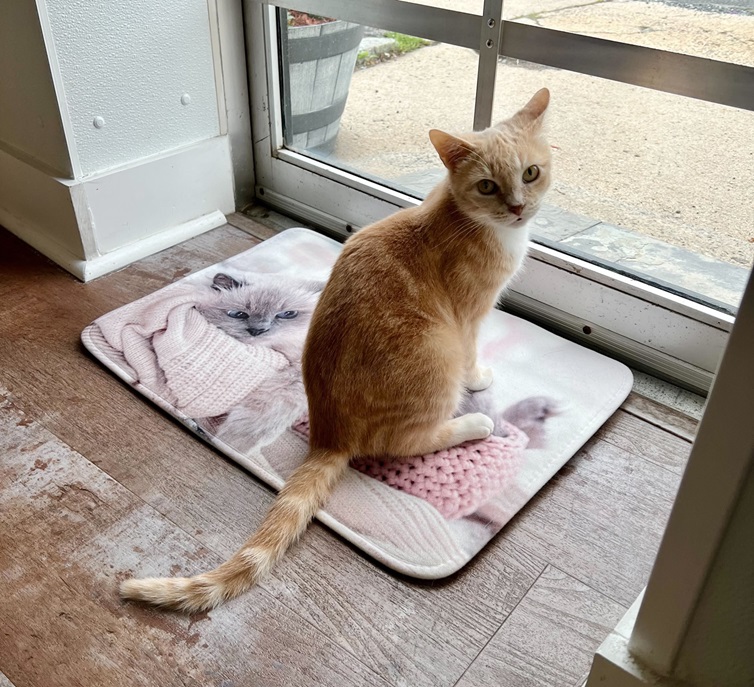One Paw at a Time: Leash Training for your cat
Written by Karma Cat Foster, Socializer, Crafting Guru, and Blog Writer, Jacqueline R.
Dogs get to walk around the neighborhood exploring and enjoying nature. This adds to their quality of life; keeping boredom at bay, giving them exercise, engaging in curiosity, and bringing them into contact with other dogs and new people. Over the past decade it has become increasingly popular to take cats out for walks too; enriching their lives in similar ways while keeping our furry friend safe. While not all cats are amenable to being leashed and exploring the great outdoors, some of the more brave and adventurous kitties might! Yes, you too can be that quirky cat person who takes their cat out on a harness and leash.
A word of caution: Your cat will likely enjoy being outside very much and crave it (possibly constantly). This may cause begging behaviors, such as loud meowing, pawing at the door, or even attempts to run out the door when least expected – they’ll know what’s out there, and they will want it! Consider whether this is something you can tolerate before you begin this journey, and what you will do if it happens. We have seen outdoor enthusiast kitties returned to the rescue because their owners brought them outdoors and the resulting behavior, and flight risk, became intolerable.

Here are some quick notes before you begin your journey!
What You’ll Need
You only need a few things: a well fitting harness, a short leash with some slack for walking (NOT a retractable leash please!), or a long leash if you intend for your cat to roam only in your yard, and some treats for rewarding good behaviors. DO NOT attach a leash to a cat’s collar. You could injure their fragile necks, and cats will surprise you with how easily they can slip through spaces as small as their head; you’ll risk them slipping the collar off.
You’ll definitely want to make sure your cat is up to date on all their vaccines, flea and tick preventatives, and microchipped in case they do manage to slip away from you.
So – here we go!
The Harness
You will need to figure out how to work the harness before you try it on your cat. Get a feel for how to adjust it, and practice securing all the buckles and belts. You could use a stuffed animal for practice. Snap and unsnap, until you feel confident with how the harness goes on and comes off. There are some final adjustments that will need to be made to size it to your cat, but for now just approximate sizing. Always thoroughly read and understand the instructions that come with the harness and leash.
Start introducing the harness and leash to kitty. Leave them lying around for kitty to sniff. They’ll want to thoroughly inspect this new contraption. Practice snapping the halter together, or undoing the velcro in front of kitty so they gets used to everything about the harness and leash. If kitty seems very shy about even looking at it, try putting it near their favorite spot like their food bowl, or favorite cushion/bed.
Once you’ve figured it out, try putting it on kitty slowly and without the leash. Let them get comfortable with it on indoors. The first reaction for most kitties will be to either fall over as if paralyzed, going wild trying to take it off, or possibly both. If there are any signs of distress or your kitty is going crazy and might injure themselves, take it off immediately, and offer kitty some treats because at least they tried! Take baby steps, and don’t rush this part – it may take several sessions before your kitty is even willing to stand up or take a step with the harness on. Once kitty is comfortable with the harness on and fastened, you can adjust to size and reward them with treats and praise.

Practice Indoors
After kitty seems comfortable with their harness on, allow them to wear it around the house for training sessions. Play with them as usual, allowing them to learn the feel of movement with a harness on. Eventually, when they seem very comfortable, you can begin to try to attach the leash for short training sessions. Stay in the house, attach the leash, and walk around. Never yank or pull on the leash or use it to drag your cat. Gently move in the direction you want to go, taking a step and then stopping. Entice kitty to follow you, and reward and encourage them when they do. Allow them time to investigate their surroundings and become familiar with the boundaries of the leash. Training sessions should start at only a few minutes, and slowly extend in time and distance before trying anything outside.
Suit Up Before Stepping Out
When you and kitty are finally ready to take the leap and try going outside, always put the harness and leash on BEFORE you open the door to head out, and pick your kitty up to carry them outside. This will help establish a routine and cues for walking and may help to discourage your kitty from seeing an open door as an opportunity to dash outside without you.

Start Exploring – Slowly
Remember you are doing this for your cat’s enrichment, and not for your daily power-walk! Let your kitty take the lead. Some cats may be perfectly content to lie still in the grass and soak up the sun, others may want to check out everything in the neighborhood. Some cats may also be overwhelmed by all the new sights and sounds and want to go back inside ASAP. Follow their lead and be encouraging with pets and treats.
Don’t try to force the cat to walk or move anywhere. It’s all about making the experience enjoyable for kitty. If they instantly dart back inside or freeze up when you go out, you can try again in a few days to see if they gradually become more comfortable with the outside world. But if the situation doesn’t improve, leash training may not be an activity your kitty enjoys
When you start walking and exploring, be sure to always be aware of your surroundings and any dangers that may be in the environment. Do not let your cat eat random things they find or walk on grass that has been treated with chemicals (for this reason, your own untreated yard may be the safest place to have this experience). Stay clear of other animals, especially dogs, even if they look friendly. Cats are notoriously territorial, and even if you think they are looking for a new friend, that may not be the case.
There are plenty of ways to build your relationship with your kitty and have fun together. Walking on a leash is only one way. If you kitty doesn’t enjoy it, don’t worry there are plenty of other things you can do to have fun together. Happy trails!!!

